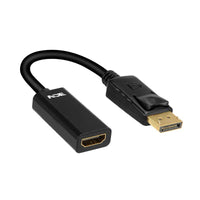DisplayPort is widely used in connecting your laptop to the monitor to provide high-quality video and audio content. DisplayPort 1.4 is the most common version used in daily life. The next version of DisplayPort is DisplayPort 2.0. This giant change in number usually indicates a huge upgrade. Has DisplayPort 2.0 carried the new features we are longing for? Will an upgrade to DisplayPort 2.0 bring a significant improvement to our experience? What are the differences between DisplayPort 1.4 and 2.0? Which one should you choose? We will dig into the contrasts between these two versions to help your decision-making process.
What is DisplayPort 1.4?
As one of the most common digital display interfaces to connect video and audio data to various display devices, DisplayPort never stops renewing itself. Launched on March 1, 2016, DisplayPort 1.4 has been very popular for its powerful compatibility. It features DisplayPort Dual-Mode and Alternate (Alt) Mode. The Dual-Mode allows the DisplayPort to connect DisplayPort sources to DVI and HDMI displays or vice versa. The Alt Mode enables DisplayPort to be compatible with USB Type-C connectors or Thunderbolt interfaces. Moreover, DisplayPort 1.4 also has other added new features.
Key Features of DisplayPort 1.4
- Transmission Capability
DisplayPort 1.4 has the same bandwidth as its predecessor - DisplayPort 1.3, at 32.4 Gbps. Since 20% of the bandwidth is spent on DC balancing, the total data rate can only reach 25.92 Gbps. Even so, DisplayPort 1.4 can meet higher standards by introducing the DSC technology of VESA. Designed for 4K, DisplayPort 1.4 supports up to 8K resolution.
- Display Stream Compression (DSC)
DSC is a video compression algorithm that complies with the ISO/IEC 29170 visually lossless compression standard. In most cases, images compressed by this algorithm are visually indistinguishable from the uncompressed images. DSC 1.2 version adopted in DisplayPort 1.4 can compress video volume by a ratio of up to 3:1. Featuring DSC technology, DisplayPort 1.4 can reach high resolution and refresh rate to offer a high-quality visual experience.
- Forward Error Correction (FEC)
FEC is a method of detecting and correcting errors in data transmission through special codes. Relying on the error correction capability of FEC, less data needs to be retransmitted during transmission, thereby reducing bandwidth consumption. Moreover, coordinating with DSC, FEC provides transport error resiliency for compressed video transmission to external displays.
- HDR Meta Transport
DisplayPort 1.4 uses pre-existing auxiliary packet transmission to support the HDR10 static metadata extension of the CTA 861.3 standard and prepares flexible metadata packet transport for future dynamic HDR standards.
- Expanded Audio Transport
DisplayPort 1.3 covers eight audio channels, the Max. Sample Rate of 768 kHz, and the Max. Sample Size of 24 bits, while DisplayPort 1.4 takes a big step forward. It expands the audio channels from 8 to 32, increasing the sample rate from 768 to 1536 kHz and extending support for all known audio formats.
What is DisplayPort 2.0?
Released on June 26, 2019, DisplayPort standard 2.0 retains the above-mentioned key features of DisplayPort 1.4, such as Dual-mode, Alt mode, DSC, FEC, and HDR. But it outperforms in data bandwidth performance. DisplayPort 2.0 can provide higher refresh rates and enhanced support for high dynamic range (HDR) in high-resolution applications.
Main Features of DisplayPort 2.0
- New Transmission Modes
DisplayPort 2.0 defines three higher-speed transmission modes:
- Ultra High Bit Rate 10 (UHBR 10): 10.0 Gbps bandwidth per lane
- Ultra High Bit Rate 13.5 (UHBR 13.5): 13.5 Gbps bandwidth per lane
- Ultra High Bit Rate 20 (UHBR 20): 20.0 Gbps bandwidth per lane
Via these new transmission modes, the maximum link bandwidth of DisplayPort 2.0 can reach up to 80 Gbps. Besides, the 128b/132b encoding scheme increases the encoding efficiency of DisplayPort 2.0 to almost 97%. As a result, it achieves a maximum payload of 77.37 Gbps. This milestone was realized thanks to the partnership between VESA and Inter that enabled DisplayPort 2.0 to leverage Thunderbolt 3 Physical Interface (PHY) layer specification to multiply its transmission capability.
- Full Support for 8K Resolution
DisplayPort 2.0 specification is born for 8K. It can carry an 8K (7680×4320) display at 60Hz and 30 bit/px full color 4:4:4 HDR without any compression. With the aid of DSC, it supports two 8K displays at 120Hz and 30 bit/px full color 4:4:4 HDR.
- Power Saving
DisplayPort 2.0 also introduces the new feature of Panel Replay (PR). Panel replay allows static images to be stored and replayed. If the content changes with the video frame update, the system video processor or graphics processing unit (GPU) only needs to operate a partial update to the changed portion. In this way, unnecessary power consumption of the display and processor decreases, and we can enjoy an accelerated charging speed.
DisplayPort 1.4 vs 2.0
Now that you learn what DisplayPort 1.4 and DisplayPort 2.0 are. To figure out the differences, we will compare them in the following content.

Higher Bandwidth
The most remarkable improvements of DisplayPort 2.0 compared to DisplayPort 1.4 are the better bandwidth and refresh rate. DisplayPort 2.0 has a nearly three-fold increase in maximum payload bandwidth from 25.92 Gbps to 77.37 Gbps. Thus,
- While DisplayPort 1.4 supports 8K display, DisplayPort 2.0 can support one display up to 16K;
- DisplayPort 2.0 can achieve further HDR applications;
- DisplayPort 2.0 supports 4K-and-beyond VR resolutions, elevating the user experience with augmented/virtual reality (AR/VR) displays;
- DisplayPort 2.0 maximizes gains on USB-C connectors via DisplayPort Alt Mode.
Optimized Functions
The Panel Replay is an apparent improvement of DisplayPort, permitting power saving in all-in-one personal computers and laptops with higher resolution displays. Apart from the new panel replay function, DisplayPort 2.0 also optimizes some of the original features in DisplayPort 1.4. For example, the multi-stream transport (MST) enhancement facilitates driving multiple displays on a single DisplayPort interface. DisplayPort 2.0 can support three 4K displays at the rate of 90 Hz without compression.
Enhanced Compatibility
DisplayPort can be easily backward compatible with traditional display interfaces such as VGA, DVI, FPD-link, and HDMI with active or passive adapters. With an active DisplayPort to HDMI adapter, the conversion from DisplayPort to HDMI can be achieved even without Dual Mode. DisplayPort 1.4 includes support for the Rec. 2020 color space in consideration of interoperability with high-definition multimedia interface (HDMI).
Relatively, DisplayPort 2.0 strengthens seamless interoperability with USB4, USB Type-C connector, and Thunderbolt interface through the subsequently updated DisplayPort Alt Mode version 2.0, promoting the convergence of various standards as well as maximizing the application scope of DisplayPort itself.
The following chart offers a sum comparison of the different specifications and features between DisplayPort 1.4 and DisplayPort 2.0:
|
DisplayPort Specs |
DisplayPort 1.4 |
DisplayPort 2.0 |
|
Single Display Configurations |
8K display at 60 Hz and 30 bit/px 4:4:4 HDR (with DSC) 8K display at 30 Hz and 24 bit/px 4:4:4 (no compression) 4K display at 240 Hz and 30 bit/px 4:4:4 HDR (with DSC) 4K display at 60 Hz and 30 bit/px 4:4:4 HDR (no compression) |
16K display at 60 Hz and 30 bit/px 4:4:4 HDR (with DSC) 10K display at 60 Hz and 24 bit/px 4:4:4 (no compression) 8K display at 144 Hz and 30 bit/px 4:4:4 HDR (with DSC) 4K display at 240 Hz and 30 bit/px 4:4:4 HDR (no compression) |
|
Maximum Bandwidth |
32. 4 Gbps |
80 Gbps |
|
Maximum Link Rate |
8.1 Gbps/lane |
20 Gbps/lane |
|
Maximum Payload |
25.92 Gbps |
77.37 Gbps |
|
Encoding Scheme |
8b/10b encoding |
128b/132b encoding |
|
Compression (Optional) |
DSC 1.2 |
DSC 1.2a |
|
FEC |
Optional |
Mandatory |
|
MST |
Optional |
Default |
|
Panel Replay |
Not supported |
Supported |
|
Compatibility |
High compatibility |
Better compatibility |
|
Transmission Mode |
RBR, HBR, HBR2, HBR3 |
RBR, HBR, HBR2, HBR3, UHBR 10, UHBR 13.5, UHBR 20 |
An Upgrade, Right Now or Bide Your Time?
VESA predicts the market demand for display performance in the next few years and adds new features to the DisplayPort standard. DisplayPort is future-oriented, aiming to empower next-generation display technology while ensuring compatibility with existing devices. As such, it is not a must for individuals to pursue the latest DP version. Just choose according to your specific requirements.
For typical users, there is no urgency to rush to upgrade to DisplayPort 2.0. Here is why:
- If you use a 1080p or 1440p monitor, you will not notice any difference between DisplayPort 1.4 and 2.0.
- To benefit from DisplayPort 2.0, your monitor, graphics card, cables, and resources must all support it. If they do not, or if you do not often use video resources above 4K, DisplayPort 2.0 will not offer significant advantages.
- If your display needs are primarily for everyday activities like movie watching and working without demanding high-end display and ultra-high resolution, DisplayPort 2.0 is not necessary.
However, I will still recommend DisplayPort 2.0 for the following groups:
- Those who pursue the smooth display with high refresh rates or enjoy the image enhancement of HDR at high resolution.
- High-end gamers or VR and AR enthusiasts who benefit from higher refresh rates and want to avoid the potential differences and delays from DSC.
- Individuals who require viewing or editing high-resolution videos.
- Users with dual monitor setups or those who engage in multiplayer gaming.
Final Thoughts
DisplayPort stands out due to its cutting-edge digital protocol, versatile foundation, and impressive display capabilities. Though DisplayPort 1.4 may become outdated eventually, you probably will not require DisplayPort 2.0 so soon. However, if you ever find yourself craving top-tier display performance, DisplayPort 2.0 could be the ideal solution. With the further development of DisplayPort and the spread of 4K ultra-high refresh rates, 8K displays, and OLED TVs, DisplayPort 2.0 and the latest DisplayPort 2.1 will be preferable options.
For more information on this topic, you can keep up on our blogs. While VCELINK offers general and basic information for our customers and other visitors to the website, it’s not professional advice.




Be the first one to comment.
Leave a comment